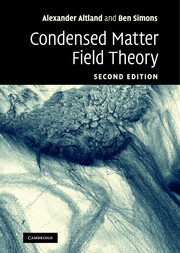Book contents
- Frontmatter
- Contents
- Preface
- 1 From particles to fields
- 2 Second quantization
- 3 Feynman path integral
- 4 Functional field integral
- 5 Perturbation theory
- 6 Broken symmetry and collective phenomena
- 7 Response functions
- 8 The renormalization group
- 9 Topology
- 10 Nonequilibrium (classical)
- 11 Nonequilibrium (quantum)
- Index
8 - The renormalization group
Published online by Cambridge University Press: 04 August 2010
- Frontmatter
- Contents
- Preface
- 1 From particles to fields
- 2 Second quantization
- 3 Feynman path integral
- 4 Functional field integral
- 5 Perturbation theory
- 6 Broken symmetry and collective phenomena
- 7 Response functions
- 8 The renormalization group
- 9 Topology
- 10 Nonequilibrium (classical)
- 11 Nonequilibrium (quantum)
- Index
Summary
The method of the renormalization group (RG) provides theorists with powerful and efficient tools to explore interacting theories, often in regimes where perturbation theory fails. Motivating our discussion with two introductory examples drawn from a classical and a quantum theory, we first become acquainted with the RG as a concept whereby nonlinear theories can be analyzed beyond the level of plain perturbation theory. With this background, we then proceed to discuss the idea and practice of RG methods in more rigorous and general terms, introducing the notion of scaling, dimensional analysis, and the connection to the general theory of phase transitions and critical phenomena. Finally, to conclude this chapter, we visit a number of concrete implementations of the RG program introduced and exemplified on a number of canonical applications.
In Chapter 5, ø4-theory was introduced as an archetypal model of interacting continuum theories. Motivated by the existence of nonlinearities inherent in the model, a full perturbative scheme was developed, namely Wick contractions and their diagrammatic implementation. However, from a critical perspective, one may say that such perturbative approaches present only a limited understanding. Firstly, the validity of the ø4-action as a useful model theory was left unjustified, i.e. the ø4-continuum description was obtained as a gradient expansion of, in that case, a d-dimensional Ising model. But what controls the validity of the low-order expansion? Indeed, the same question could be applied to any one of the many continuum approximations we have performed throughout the first chapters of the text.
- Type
- Chapter
- Information
- Condensed Matter Field Theory , pp. 409 - 495Publisher: Cambridge University PressPrint publication year: 2010



